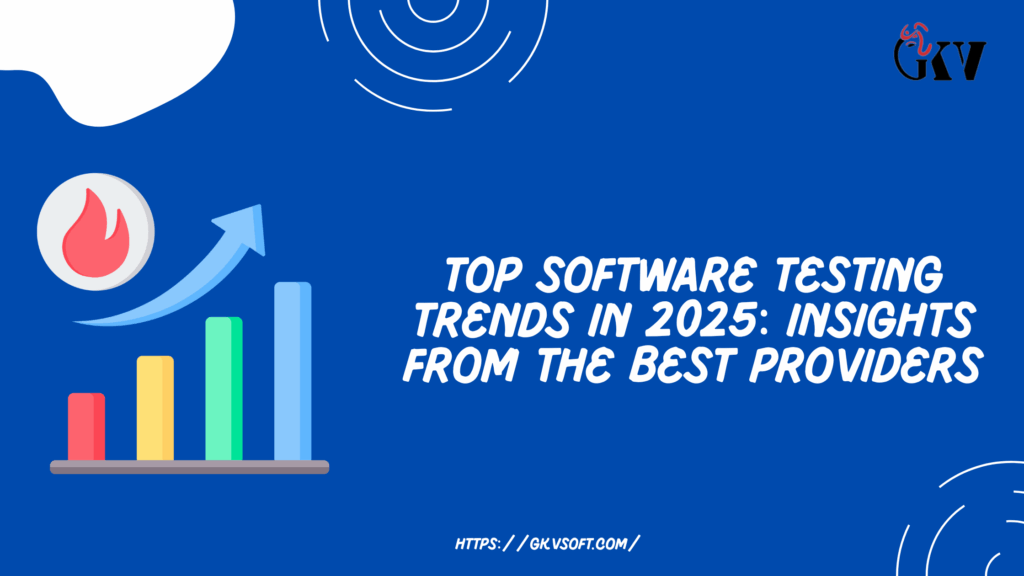The year 2025 comes with its own set of challenges and advancements in the field of software testing. Organizations are updating their procedures to adopt new Software testing trends that focus on achieving quality, security, and performance in increasingly complex digital ecosystems. The following are some of the factors that shape software testing this year together with suggestions from the best providers.
1. Utilization of AI in Automation Testing
The introduction of AI has changed almost every activity including software testing, especially with truly autonomous capabilities:
Development of test scenarios inspired by actual users
Broken test scripts have a self-healing feature
Risk Evaluation dependent prioritization of tests
Anticipating failures and performing them in the most optimistic scenarios
We are witnessing a transition from AI-assisted to AI-autonomous testing, noticed Dr. Maria Chen at TestSphere. Today’s devices are capable of entire testing cycles being performed autonomously along with enhancements through machine learning.
The people who have autonomous testing integrated into their systems report up to 70 reduced testing time and 45 percent fewer escaped defects.
2. Testing Security Against Quantum Threats
With the growth of quantum computing in 2025, more advanced security testing will cater to emerging threats, these include:
Assessing vulnerability to quantum decryption
Adopting post-quantum cryptography
Emulating quantum strike simulations
Validating quantum-proof identity verification
Alejandro Vega of Secure Logic states, “Quantum computing gives birth to additional difficulties for existing security frameworks.” Hence, organizations have to defend against quantum attacks even if the technology is still in the works.”
The rest of the industry appears to be lagging behind, but quantum resilient testing has already been adopted by 63% of major banks.
3. Automated Data Generation for Testing
The compliance regulations pertaining to user privacy have spurred advancements in automated data generation for testing:
Producing accurate information that replicates actual production data
Creating edge occurrences that are infrequently present in real-world data
Complying with privacy laws by not revealing sensitive information
Providing homogeneous data to other environments within the testing framework
According to Priya Sharma of TestMind, “The quality of synthetic data has surpassed expectations.” It is surpassing industry standards because clients cannot distinguish real from synthetic data, but the compliance risks associated with synthetic data mitigate everything.
Currently, 78% of large organizations have integrated synthetic data into their testing procedures.
4. Collaborative DevTestSecOps
The intersection of development, testing, security, and operations is becoming increasingly blurred. There are modern methods such as:
Common security and quality concerns
DevSecOps platforms provide integrated testing.
Real time feedback loops for quality.
Policy enforcement throughout the entire development.
As Jordan Taylor from CloudCycle states, “Testing is no longer a distinct phase; it has evolved into a continuous effort embedded in every stage of the software development lifecycle.”
80% of organizations with mature DevTestSecOps practices report increased speed to market, along with 65% reduction in production issues.
5. Experience-Centric Testing
In 2025, user experience will be at the core of testing strategies:
Sentiment analytics during user acceptance testing.
Measuring biometrics.
Emotion detection during beta testing.
Thorough accessibility evaluation.
“The question was no longer does it work, the question is how does it feel to use it?” explains Olivia Wilson from ExperienceLab. “Now companies measure emotional responses to PhD level metrics.”
Organizations focused on experience report 40% in user satisfaction and 25% in customer retention.
6. Platforms for Testing With Low-Code/No-Code
Opportunities for testing in tandem with software development have surfaced in parallel with the growth of low-code development workflows:
– Enabling visual test creation for non-technical users
– AI-driven automation of test creation from user stories
– Automated maintenance of tests in tune with application changes
– Ecosystem integration with enterprise testing tools
“With every new advancement in low-code testing platforms, quality assurance is enhanced everywhere,” Michael Johnson of SpeedTest Solutions says. He adds, “Non-coders can now domain experts formulate complex tests with ease.”
It is predicted that by 2025, around 70% of new enterprise applications will depend on low-code technologies, and testing platforms will increasingly adapt to this shift.
7. Low-Code Or No-Code Intelligent Test Environment Management
The low-condition features of intelligent systems that process test environments include:
– Automatically building environments for specific testing needs
– Allocating cloud resources efficiently and economically for facilitating testing
– Using analytics to anticipate and predict necessities related to the environment
– Generating replicas of production environments with high accuracy
“This is how Keiko Tanaka from TestCloud described intelligent test environments, ‘They have cleared a whooping bottleneck.’ Focusing more on the creative side of technology has become the main goal for many groups because waiting for these environments, troubleshooting configuration problems, is a hassle deal more crippling.'”
Using intelligent tools to manage environments helps minimize delays by up to 55%, and shrink expenses related to testing infrastructure by 30%.
8. Testing the API Ecosystem
Testing APIs is essential with API-first architectures as a focal point of development:
– Contract testing between services;
– Chaos testing for API resilience;
– Security testing for API vulnerabilities;
– Performance testing across the API ecosystem.
“Organizations need to verify not just individual endpoints but entire ecosystems of interconnected services,” explains Rajiv Patel of Interface Guard.
This marks a trend worth noting as 92% of organizations use microservices in some form to some of their applications.
9. Testing for Sustainability
There’s new testing bound to catch the attention of many—evaluating how a company’s software impacts the environment:
– Energy consumption under different scenarios
– Carbon footprint linked to cloud applications
– Resource efficiency of algorithms
– Impact on battery life on mobile devices
“Software efficiency directly impacts energy consumption and emissions,” Emma Green from EcoCode points out. “It’s undeniable now that organizations understand optimization goes beyond performance.”
Tech giants such as Google and Microsoft have pioneered establishing those standards.
10. Regulatory Compliance Automation
Compliance verification becoming automated is key in today’s world due to ever-evolving regulations.
– Tracking compliance rule changes across geographies
– Generating sophisticated tests as per compliance prerequisites
– Utilizing existing compliance test suites
– Generating reports required for audit automatically
“Today’s technology and manual approaches to compliance testing are incompatible,” comments RegTest’s Thomas Weber “Without automation, continuous compliance can never be achieved.”
Such automation in testing is critical for healthcare, finance, and aviation sectors where the cost of not complying is too high.
Conclusion
Testing software at 2025 is not considered a quality control phase anymore; it has transitioned to a strategic role in business planning and development. Companies accepting these trends gain a competitive advantage through speed, quality, and user satisfaction.
The most innovative companies are implementing AI solutions for autonomous testing, experience-centric software verification, and sustainability-focused testing techniques, enabling them to outpace competitors and deliver remarkable software products.

